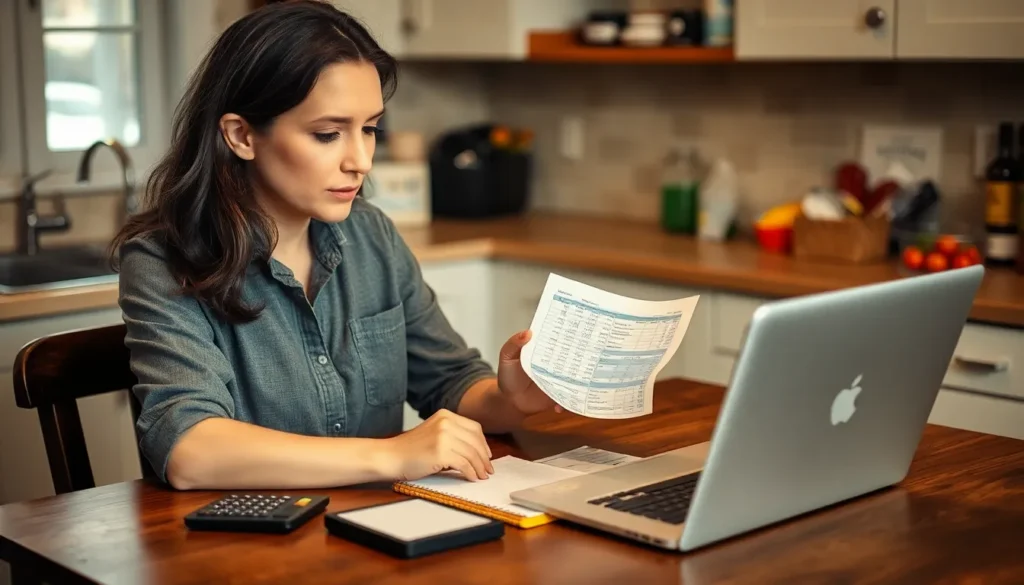When it comes to numbers, some might think they’re as exciting as watching paint dry. But what if we told you that calculating 5% of 200,000 could unlock a treasure trove of insights? Whether you’re budgeting for that dream vacation or just trying to impress your friends with your math skills, understanding percentages is key.
Table of Contents
ToggleOverview of Percentage Calculations
Percentages represent a fraction of 100. Understanding how to calculate a percentage involves simple arithmetic. For instance, calculating 5% of 200,000 entails multiplying 200,000 by 0.05. The equation yields 10,000.
Mastery of percentage calculations extends beyond academic settings. Individuals apply these skills in budgeting, investing, and shopping. For example, knowing how to find discounts during sales can lead to significant savings.
Breaking down percentages enhances comprehension. A percentage often denotes parts of a whole, making abstract concepts more tangible. In practical terms, 5% signifies 5 parts out of every 100.
Percentage calculations also facilitate comparisons. Analyzing changes over time becomes easier when using percentages. For example, if a population grows from 200,000 to 210,000, the percentage increase stands at 5%, calculated by dividing the difference (10,000) by the original number (200,000).
Using percentages in everyday life simplifies decision-making. Individuals benefit from quickly assessing loan interest rates or investment returns. Familiarity with percentage calculations empowers better financial decisions.
Practicing these calculations leads to increased confidence in managing finances. The ability to calculate percentages not only aids in budget management but also develops critical thinking. Engaging with these concepts leads to a more intuitive understanding of numbers in various contexts.
Understanding 5% of 200,000

Understanding percentages is critical for various tasks, including financial decisions. Calculating 5% of 200,000 requires straightforward arithmetic.
Step-by-Step Calculation
Start by converting 5% to its decimal form, which equals 0.05. Next, multiply 200,000 by 0.05. Performing this calculation gives you 10,000. This figure represents 5% of 200,000 and illustrates the simplicity of percentage calculations. Mastering this process enhances numerical confidence and aids in financial assessments.
Real-Life Applications
Individuals encounter percentage calculations in daily scenarios. When budgeting, understanding percentages helps evaluate expenses. Investors analyze returns using similar calculations. Retail shoppers determine discount prices by calculating percentages off the original amount. In finance, knowing how to assess interest rates simplifies loan decisions. Accurate percentage knowledge fosters strategic decision-making across many financial contexts.
Importance of Percentage in Financial Contexts
Understanding percentages plays a crucial role in managing personal finances. They help in making informed decisions across various financial scenarios.
Budgeting and Resource Allocation
Budgeting relies heavily on percentages to track income and expenses. Individuals can effectively allocate resources by identifying fixed and variable costs in percentage terms. Knowing that 30% of income should go to housing ensures balanced spending. Analyzing expenses as percentages supports adjustments, allowing individuals to prioritize essential needs. When individuals recognize that 15% of their budget goes to entertainment, they can decide whether to cut back. Accurate percentage calculations also prevent overspending, ensuring financial stability.
Investment Evaluations
Investment evaluations require a strong grasp of percentages to assess returns. By comparing potential gains as percentages, investors can quickly identify which opportunities are most lucrative. An investment that yields a 12% return offers more value than one that returns 8%. Understanding tiers of interest and expected growth helps in maximizing returns. Calculating fees and expenses as percentages reveals their impact on overall performance. When individuals comprehend that a 1% fee can significantly affect long-term gains, they make more informed investment choices.
Common Misconceptions About Percentages
A common misconception is that percentages apply only to whole numbers. Percentages can also reference fractions and decimals. Some people believe adjusting a percentage requires complex calculations, yet multiplying by the decimal equivalent simplifies this task. Many assume that understanding percentages isn’t critical outside math classes. In reality, percentages frequently appear in everyday financial scenarios, like budgeting and discounts.
Another misunderstanding involves comparing percentages without context. For instance, 10% off a $200 item saves $20, while 10% off a $50 item saves only $5. These comparisons emphasize the importance of knowing the base amount when analyzing discounts or expenses. Individuals often think that reducing expenses by a percentage guarantees savings opportunities. Strategic planning ensures that applying percentage reductions leads to tangible benefits.
Confusing percentages with absolute numbers is also prevalent. Taking 5% of (200,000) produces 10,000, but not all situations use whole numbers like this. People may not recognize how percentages function as ratios in various applications. For example, assessing a loan’s interest rate displays how much one pays relative to the principal amount.
Some might believe that achieving accurate percentage calculations is unnecessary for daily life; however, understanding how to apply percentages correctly plays a vital role in financial literacy. Being skilled in percentages allows individuals to deduce insightful conclusions from data, enabling informed choices in investing or purchasing. Mastering percentages fosters confidence in navigating financial matters and develops analytical thinking.
Understanding how to calculate percentages like 5% of 200,000 is a fundamental skill that empowers individuals in their financial journey. This knowledge not only aids in personal budgeting but also enhances critical thinking and decision-making abilities. Mastering these calculations opens doors to better financial management and helps individuals navigate various scenarios with confidence.
By recognizing the practical applications of percentages in everyday life, from shopping to investing, one can make informed choices that lead to significant savings and improved financial health. Embracing this knowledge is essential for anyone looking to enhance their financial literacy and overall well-being.



